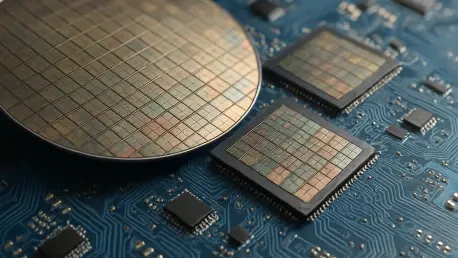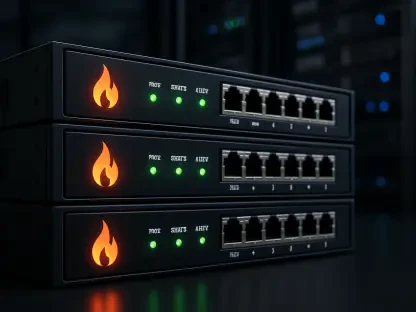In an era where artificial intelligence is redefining the boundaries of technology, a fierce competition is unfolding among the world’s leading tech companies to develop the most advanced and efficient processors tailored for AI workloads. This intense rivalry, often dubbed a “silicon arms race,” is driven by the explosive growth of generative AI applications, from sophisticated language models to intricate data analysis tools. With the stakes higher than ever, billions of dollars are being funneled into creating specialized hardware capable of powering the next generation of AI training and inference tasks. Major industry players are pushing the limits of semiconductor design, not only to gain a competitive edge but also to address the escalating demands of computing power and energy efficiency. This battle is reshaping the tech landscape, influencing everything from hyperscale data centers to edge computing environments, and setting the stage for a transformative era in digital innovation.
The Generative AI Boom Fueling Demand
The meteoric rise of generative AI stands as the primary catalyst behind the unprecedented demand for specialized processors in today’s tech industry. Projections estimate this sector could balloon to a staggering $1.3 trillion by 2032, prompting colossal investments from tech giants eager to capitalize on this growth. Amazon has committed $150 billion to bolster its data center infrastructure, while Google is allocating $25 billion for similar expansions. Microsoft, in partnership with key AI innovators, is investing a staggering $100 billion into a cutting-edge AI supercomputer. These massive financial commitments underscore a critical dependency on advanced processors engineered to manage the immense computational workloads required for AI training and inference. Without such hardware, the ambitious goals of scaling generative AI applications to meet global demand would remain out of reach, highlighting the urgent need for innovation in chip design to support this technological revolution.
This surge in demand for AI capabilities is not merely a trend but a fundamental shift in how technology infrastructure is being built and scaled. The complexity of generative AI models, which can involve billions of parameters, necessitates hardware that can process vast datasets with speed and precision. Beyond raw performance, these processors must also tackle the challenge of energy consumption, as inefficient systems could lead to unsustainable operational costs. Companies are therefore racing to develop chips that balance power with efficiency, ensuring that the infrastructure supporting generative AI can keep pace with its rapid adoption across industries. From healthcare to entertainment, the applications of this technology are vast, and the processors powering them are becoming the backbone of a new digital economy, driving further investment and competition in the semiconductor space.
Competition Heats Up Among Chip Designers
At the forefront of this silicon race are industry titans like NVIDIA and Google, whose innovations in processor technology are setting new benchmarks for performance. Google’s Ironwood TPU, for instance, achieves a remarkable 42.5 exaflops at scale, while NVIDIA’s Rubin CPX GPU delivers an impressive 30 petaflops on a single die. These advancements are not just about raw computational power; they also emphasize energy efficiency, a critical factor in scaling AI infrastructure. NVIDIA, holding over 80% of the market share with its Hopper architecture and CUDA ecosystem, has become the go-to supplier for AI hardware. However, this dominance is being contested as other players strive to carve out their own space in the market, reflecting a broader industry push to avoid over-reliance on a single provider and to foster a more competitive landscape.
Challenging NVIDIA’s stronghold are companies like Microsoft, Amazon, AMD, and Intel, each developing alternative solutions to meet specific needs. Microsoft is advancing its Azure Maia AI chips and Cobalt CPUs, while Amazon strategically blends partnerships with NVIDIA and in-house innovations. AMD’s MI300 and Intel’s Gaudi3 GPUs offer cost-effective options for organizations seeking flexibility over proprietary systems. This competitive dynamic is further intensified by NVIDIA’s response, including the Blackwell GPU, which promises up to 25 times lower cost and energy use for large language model inference, alongside a $30 billion initiative for custom chip production. The result is a vibrant ecosystem where rivalry drives rapid advancements, ensuring that AI processor technology evolves at a breakneck pace to meet diverse industry demands and reduce dependency on any single entity.
Power and Thermal Challenges in High-Performance Computing
The extraordinary capabilities of modern AI processors come with a significant drawback: their enormous power consumption and the resultant heat generation pose substantial challenges. High-performance chips, such as AMD’s Instinct MI300X GPU, can draw up to 750 watts per unit, while NVIDIA’s B200 GPUs reach a staggering 1,200 watts. When scaled to server racks, these figures translate into power demands of up to 60,000 watts for just 20 servers, excluding additional components. Such intense energy requirements far surpass the limits of traditional air-cooling systems, which struggle to maintain optimal temperatures under these conditions. The industry is thus compelled to explore alternative cooling methods to prevent overheating, ensure consistent performance, and protect the longevity of expensive hardware critical to AI operations.
To address these thermal challenges, advanced liquid cooling solutions are rapidly becoming the standard in high-performance computing environments. Unlike air cooling, liquid cooling can transfer heat up to 30 times more efficiently, making it ideal for managing the extreme thermal design power of modern processors. This technology not only sustains peak performance but also reduces overall energy consumption by minimizing the need for excessive cooling infrastructure. As data centers scale to accommodate the growing demands of AI workloads, adopting such innovative cooling methods is essential for maintaining operational efficiency and sustainability. The shift toward liquid cooling reflects a broader recognition that managing power and heat is just as critical as enhancing computational speed in the design of next-generation AI hardware.
The Edge Computing Revolution
As generative AI applications expand beyond centralized data centers into edge computing environments, the demand for specialized processors tailored for real-time processing is intensifying. Edge computing, which brings computational power closer to end users, requires hardware that can deliver low-latency responses for applications like autonomous systems and smart devices. Specialized AI processors are pivotal in meeting these needs, enabling faster data processing without the delays associated with transmitting information to distant servers. This decentralization of computing power is reshaping how technology is deployed, making it more responsive and efficient across a range of industries, from manufacturing to retail, where immediate decision-making is often critical.
The push for edge computing also amplifies the need for robust cooling and compact hardware designs that can operate effectively in constrained environments. Unlike hyperscale data centers with vast resources for thermal management, edge deployments often face space and power limitations, necessitating innovative solutions. Custom chips designed for specific AI inference tasks are becoming indispensable, as they optimize performance while minimizing energy footprints. This trend signals a broader transformation in data center architectures, where the integration of tailored processors and advanced cooling technologies is essential for supporting the growing complexity of AI at the edge. The evolution of these systems promises to enhance user experiences by ensuring seamless, real-time interactions with AI-driven technologies.
Industry Trends Toward Efficiency and Diversification
A defining trend in the AI processor market is the industry-wide shift toward energy efficiency, driven by the need to balance performance with sustainability. While raw computational power remains a priority, there is a growing consensus that unchecked energy consumption and heat output are unsustainable in the long term. Innovations such as single-phase direct-to-chip liquid cooling are gaining traction for their ability to manage high thermal design power effectively while keeping costs in check. Additionally, emerging technologies that integrate thermal management directly into chip substrates demonstrate a forward-thinking approach to hardware design. These advancements are crucial for scaling AI infrastructure without compromising environmental or economic considerations, reflecting a maturing market focused on long-term viability.
Parallel to the emphasis on efficiency is the push for diversification within the processor landscape, challenging the dominance of market leaders like NVIDIA. Competitors, including Google with its custom TPUs for Gemini AI models, Microsoft with Azure Maia chips, and Intel with Gaudi3 GPUs, are actively developing alternatives to cater to specific workload requirements. This diversification reduces vendor lock-in and fosters a competitive environment where innovation thrives through both rivalry and collaboration. The result is a dynamic market poised for continuous evolution, where specialized processors are tailored to meet varied needs, from cost efficiency to performance optimization. Looking back, the strides made in diversifying chip options and prioritizing sustainable designs have laid a strong foundation for future advancements, ensuring that the industry adapts to meet the complex demands of AI technology with resilience and ingenuity.









